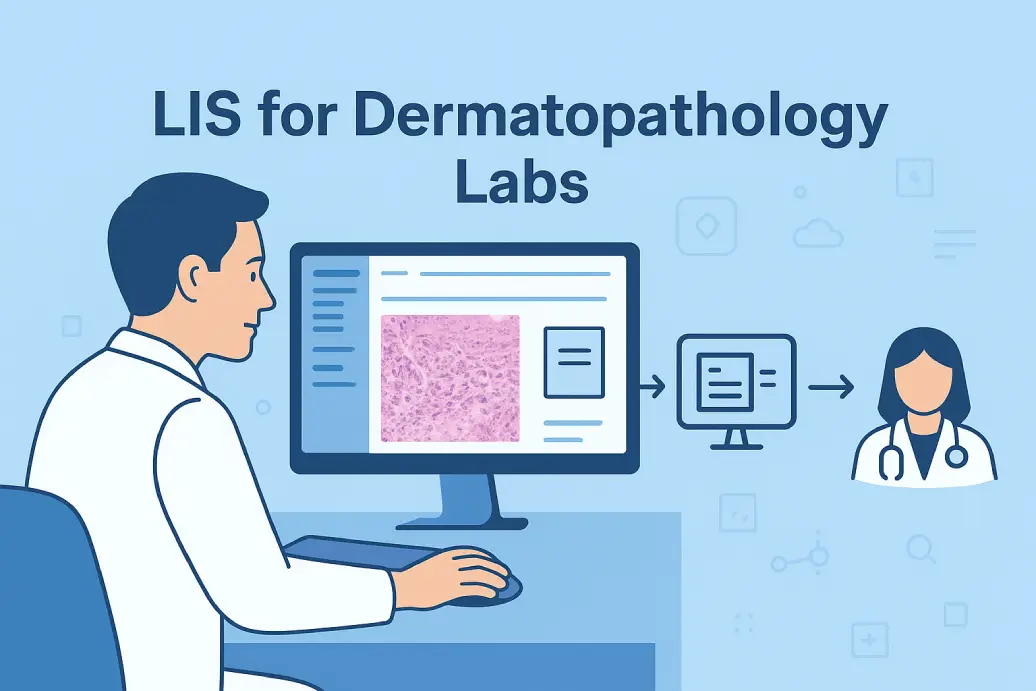Abstract
In dermatopathology, time and accuracy are immeasurably more important. Each skin biopsy is a manifestation of uncertainty of a patient, the anxiety of a family and the responsibility of the clinician. The increased caseloads, sophisticated diagnoses and the increasing need to turnaround cases within a shorter period have rendered typical systems to be ineffective in contemporary dermatopathology labs. What is required is more than a software solution, it needs an LIS that is able to capture the specifics of this area, one that guides efficiency, improvement and collaboration. This paper discusses what is really important when choosing an LIS in dermatopathology and how the future of specialty labs will look with solutions that prioritize humans, accuracy and compassion.
The Need for a Specialized LIS in Dermatopathology
Dermatopathology is not any other type of pathology; it is a specialty which falls between clinical dermatology and microscopic diagnosis. Examples of shave biopsy of a mole, punch biopsy of a rash, excisional biopsy of a suspected melanoma, these specimens all have greater stories about them than what can be seen on a slide.
For dermatopathology labs, the challenges are unique:
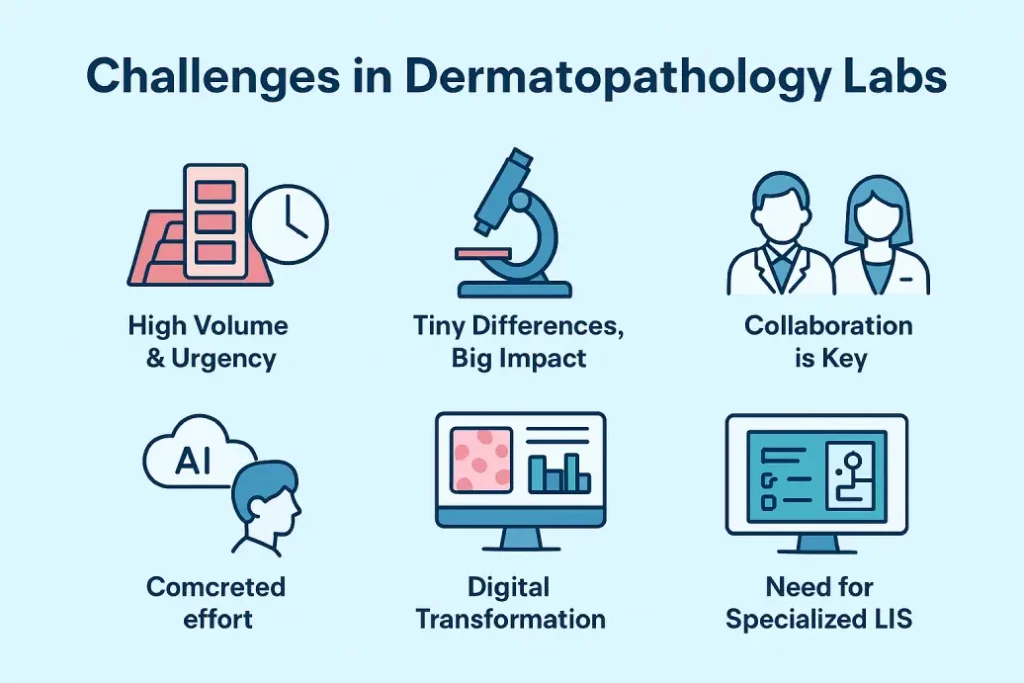
- Volumes with sense of urgency – The sudden arrival of hundreds of skin biopsies each day may be followed by the need to report quickly.
- Delicate differences – The slightest differences under the microscope can spell the difference between a benign lesion and cancerous melanoma.
- Concerted effort – Dermatologists depend heavily on accurate reports within a reasonable period of time in order to be able to treat skin conditions.
- Digital transformation – digital pathology and AI are entering mainstream practice, and labs require the systems with the ability to integrate these innovations.
LIS systems with some of these nuances are often ignored by generic LIS products, forcing labs into a system that is not designed to fit their workflow. That’s why dermatopathology labs are increasingly turning to customized LIS solutions designed to align with their specific needs, rather than the other way around.
SpeedsPath: Redefining LIS for Specialty Labs
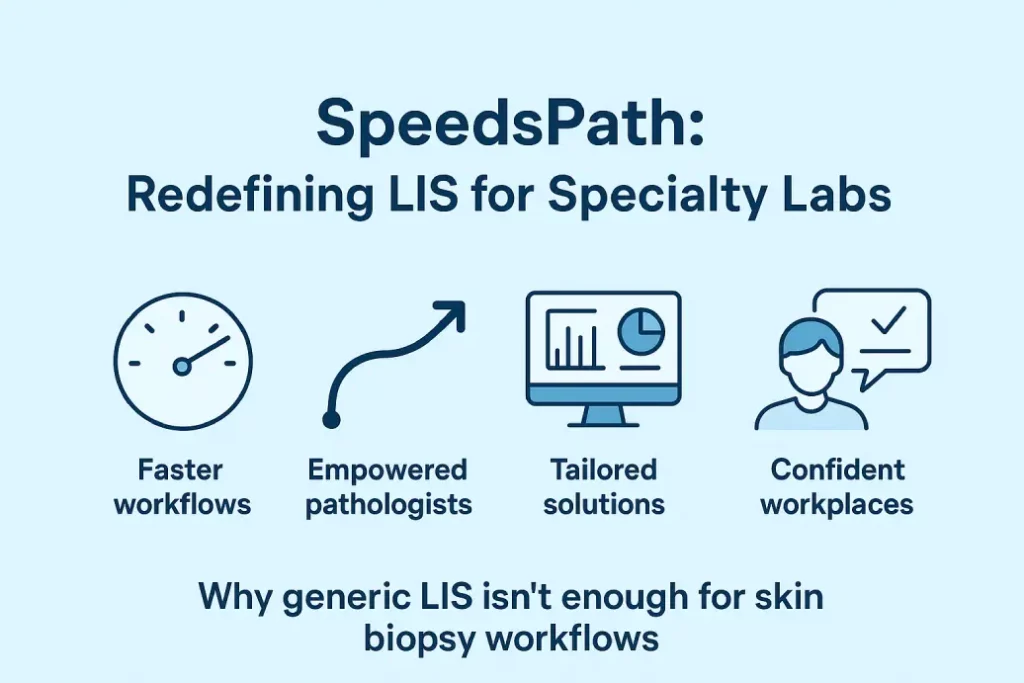
At SpeedsPath, we believe technology in healthcare should feel like an enabler, not an obstacle. Our systems are not about replacing people; they are about empowering them. A pathologist shouldn’t be bogged down by clunky workflows or limited reporting tools; they should be free to focus on interpretation and insight. With decades of expertise, we’ve built a pathology LIS system specifically for specialty labs like dermatopathology. All our features are guided by a single objective: to have labs run quicker, more efficiently, and more collaboratively, but always with a focus on the most important matters, at the center of it all, to our lab partners and their dermatology clients. Where other LIS providers deliver one-size-fits-all systems, SpeedsPath delivers tailored experiences from barcode-driven specimen and case management to image-rich reporting and built-in collaboration tools. Also, our solutions are crafted to optimize workflows and restore confidence to lab teams, clinicians, and patients.
What Matters Most in a Dermatopathology LIS
When choosing an LIS for specialty labs, the decision is not about ticking boxes. It’s about finding a system that truly transforms how a dermatopathology lab operates. Here are the areas that matter most:
1. Specimen Management Tailored to Dermatopathology

Skin specimens come in various forms, including shave, punch, and excisional biopsies, each of which can yield multiple slides or blocks. A strong LIS should:
- Track every specimen and pathology case with barcode-driven accuracy.
- Handle split and merged cases without confusion.
- Give lab staff timely visibility into case progress.
This prevents errors, saves time, and protects the integrity of every pathology case.
2. Image-Integrated Reporting
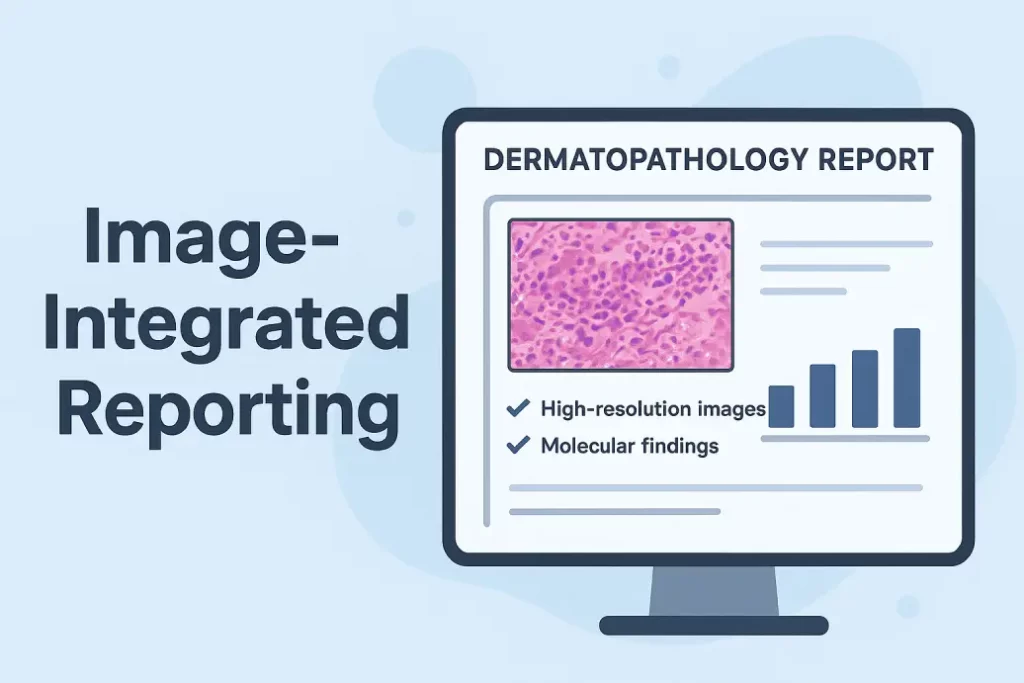
Reports in dermatopathology often require more than words, necessitating high-resolution images and molecular findings. A customized LIS should:
- Embed digital images directly into reports.
- Support immunohistochemistry and molecular testing.
- Offer flexible templates that adapt to lab preferences.
At SpeedsPath, our reporting tools are designed to create reports that are not only informative but also actionable, clear for dermatologists, detailed for pathologists, and useful for everyone involved in patient care.
3. Workflow Optimization for High Volumes
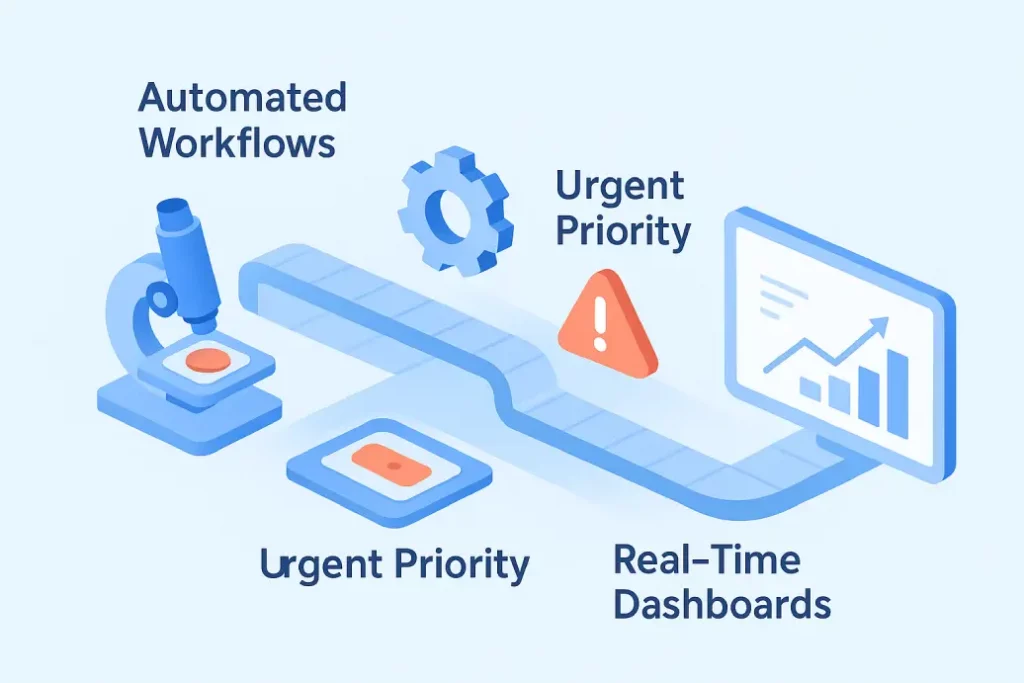
In dermatopathology, delays aren’t just inefficiencies; they can cause patients to wait longer for critical answers. A strong LIS ensures:
- Workflows are automated and simplified.
- Urgent cases are highlighted and their priorities of attention given.
- Through dashboards, turnaround times can be seen in real-time.
With lab workflow optimization, labs reduce stress, improve throughput, and maintain accuracy even during periods of peak workload.
4. Built-In Collaboration Tools
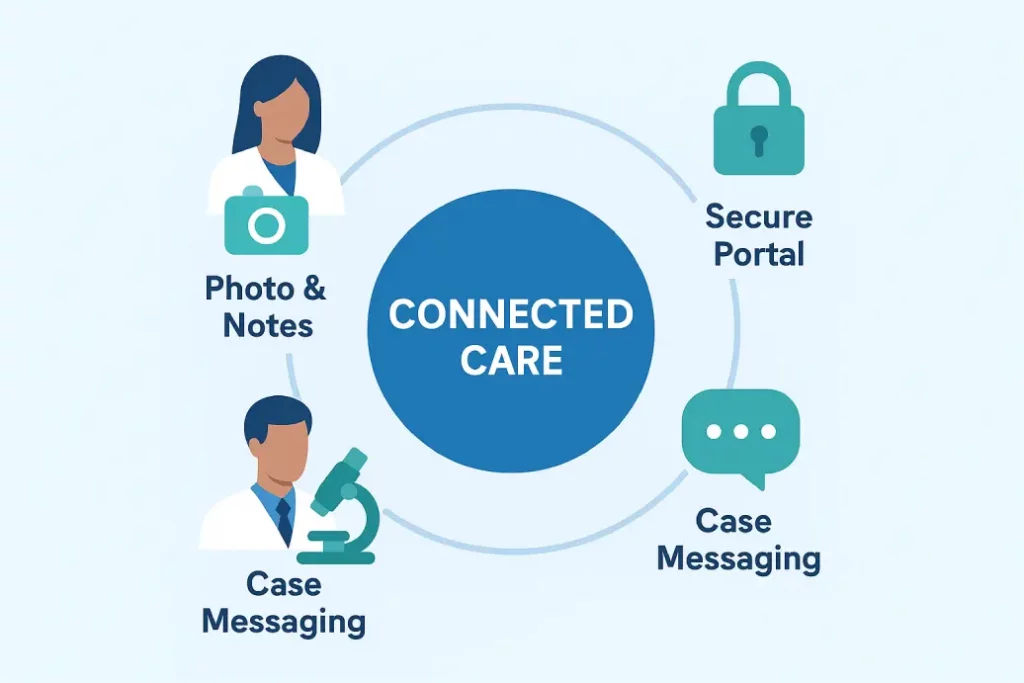
Pathologists and dermatologists must maintain a close connection. A dermatopathology LIS should:
- Provide secure clinician portals.
- Allow dermatologists to submit clinical photos and notes with biopsy requests.
- Enable case-specific messaging directly in the system.
SpeedsPath enables this collaboration so reports aren’t just delivered, they become part of an ongoing dialogue that improves outcomes.
5. Compliance and Security at the Core
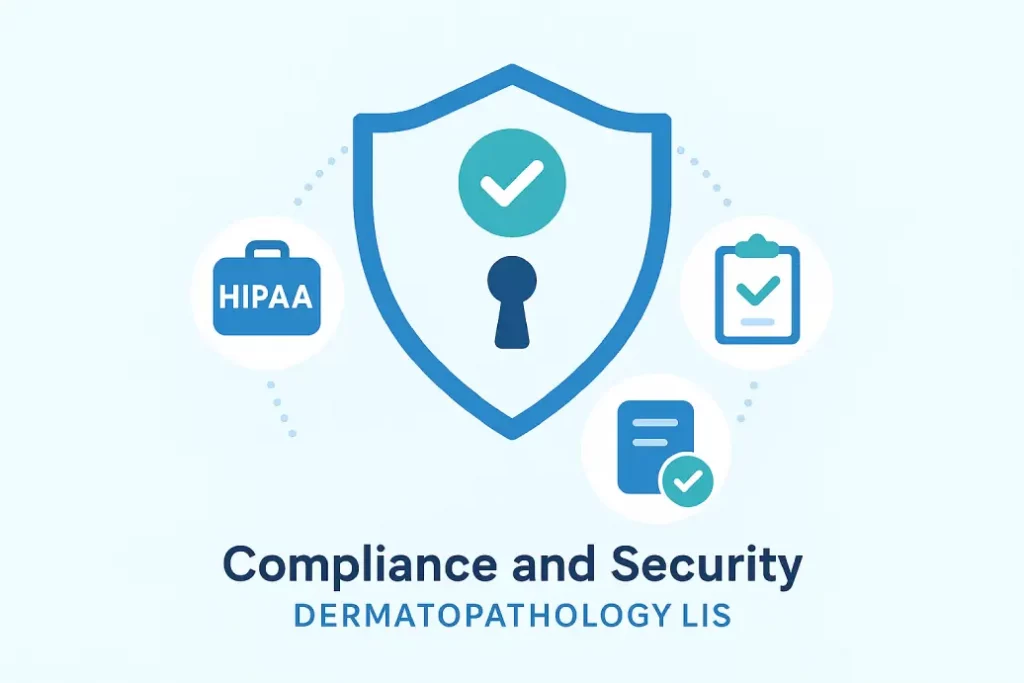
Trust is fragile, especially when it comes to patient health information (PHI). A dermatopathology LIS must guarantee:
- HIPAA-compliant protections
- Full audit trails for accountability
- Automated coding and billing checks for dermatopathology-specific procedures
SpeedsPath AP LIS builds compliance and security into every layer, ensuring labs move quickly without compromising responsibility.
6. Flexibility and Scalability

Each lab is individual, and all of them change with time. That’s why a pathology LIS system must be scalable:
- As the lab is expanded features can be added
- Workflows and dashboards are configurable
- It is future-ready with integrations (digital pathology, AI)
SpeedsPath systems grow with the lab, ensuring that today’s investment continues to create value in the years to come.
Beyond Features: The Human Impact

Behind every slide is a story:
- A young woman worried about a mole
- A grandfather hoping his rash is not something serious
- A family anxiously waiting for clarity
When a lab runs on a slow or generic LIS, patients are forced to wait longer for answers, dermatologists are left uncertain, and stress ripples through the entire system.
But when a dermatopathology lab operates with a specialty-focused LIS, everything changes:
- Patients get answers sooner
- Dermatologists receive reports they can act on immediately
- Lab staff feel supported, not overwhelmed
This is what drives SpeedsPath. We don’t just build systems, we help labs deliver reassurance, clarity, and care to the people who need it most.
The Future of Dermatopathology LIS
The future of dermatopathology is exciting, and LIS systems must keep pace. Key trends include:
- Digital Pathology: Whole-slide imaging provides the capability to consult, or perform telepathology, allowing much easier transferring of expertise.
- Machine learning: Pathologists will be able to recognize patterns faster with the help of machine learning, which will highlight those areas which should be examined in more details.
- Patient Empowerment: Patients have come to expect more digital access to their results that LIS platforms need to navigate to balance accessibility and security.
SpeedsPath is already preparing for this future, ensuring our LIS systems are ready for tomorrow’s challenges today.
Also Know:
- The Difference Between LIS and LIMS
- What is an AP LIS and How Does Work
- Top Benefits of AP LIS
- Application of AI to Pathology Labs
The Cost of Choosing the Wrong LIS

Not all LIS systems are created equal. Choosing a generic, ill-fitted platform can result in:
- Slower turnaround times that frustrate both patients and clinicians.
- Fragmented workflows that increase staff burnout.
- Limited scalability that forces costly replacements in the future.
The wrong LIS doesn’t just waste money, it costs trust, efficiency, and patient well-being. That’s why labs must choose carefully, focusing on solutions that fit their specialty, like SpeedsPath AP LIS.
Questions to Ask Before You Decide
When evaluating vendors, dermatopathology labs should ask:
- How does your LIS handle dermatopathology-specific workflows?
- Can the system integrate images, structured text, and molecular results into reports?
- How does your platform support workflow optimization at scale?
- Can dashboards and workflows be customized for our lab?
- What integrations with EMRs, billing, or digital pathology do you provide?
- How do you safeguard data and ensure compliance?
At SpeedsPath, these aren’t challenges; they’re the foundation of our design.
The Future of Dermatopathology LIS: A SpeedsPath Perspective
Dermatopathology practice is changing quickly and the tools for workflow optimization and results reporting need to adapt as well. The expectations of patients are increasing and so is the the complexity of the diagnostics. Therefore, dermatopathology labs cannot use outdated, rigid systems anymore. They require an AP LIS that is future adaptive, supporting the use of AI, predictable analytics and interoperability.
We do not simply build software, we plan the solutions that will fulfill the requirements of tomorrow. Our dermatopathology LIS is built with forward-looking features, ensuring labs can easily adopt innovations without disrupting their current workflow. Whether that is through the integration of digital pathology platforms, or the ability to collaborate between multiple sites, SpeedsPath enables specialty labs to move both swiftly and precisely to serve their patients. When you select SpeedsPath you are selecting more than a system; you are gaining the commitment of an organization that is focused on long-term partnership. The future of lab workflow optimization will belong to those who embrace adaptability, and with SpeedsPath, that future is within reach.
Also Read:
- What Is a Pathology Lab Information System?
- Compliance and Security in Anatomic Pathology LIS
- Top 10 Benefits of Anatomic Pathology LIS Software
- 5 Signs to Upgrade Your Pathology Reporting Software
Conclusion
Dermatopathology demands speed, precision, and collaboration, and the right LIS makes it possible. It is all about clarity that dermatologists require in order to treat with confidence. And it is about being able to provide lab personnel with the means that they need to do their job without hindrances. SpeedsPath is happy to be in the vanguard of this transformation. Our solutions are specific to specialty labs, anchored in workflow efficiency, and built with a sophisticated understanding of real-life pathology lab workflow, so we provide more than just software. We bring the way that leads to better outcomes, increased trust and healthier lives.
In the final analysis, each case is more than a specimen. It’s a story. And with the right LIS, those stories find answers when they are needed most.
Explore Our Other LIS Software According to Your Business Need.
- Anatomic Pathology LIS System
- Cytology Lab Information System
- GI Pathology Lab Information System
- Molecular Laboratory Information software
FAQs: Common Questions About Dermatopathology LIS
Q1. What is a Dermatopathology LIS and how is it different from a generic LIS?
A dermatopathology LIS is a laboratory information system tailored for skin biopsy workflows, image-rich reporting, and collaboration with dermatologists. Unlike generic LIS platforms, it addresses high specimen volumes, subtle diagnostic differences, and specialty-specific compliance needs.
Q2. Why do dermatopathology labs need a specialized LIS?
Dermatopathology labs handle urgent skin biopsies where timely and precise diagnosis is critical. A specialized LIS improves turnaround time, supports digital pathology, integrates clinical images, and ensures dermatologists get actionable reports quickly.
Q3. How does a dermatopathology LIS improve patient care?
By streamlining specimen tracking, embedding diagnostic images into reports, and reducing turnaround delays, a dermatopathology LIS ensures patients receive faster, more accurate diagnoses and treatment plans.
Q4. Can a dermatopathology LIS integrate with digital pathology and AI tools?
Yes. Modern LIS platforms like SpeedsPath are built for future readiness. They integrate with whole-slide imaging, AI-assisted diagnostics, and molecular testing workflows to enhance accuracy and efficiency.
Q5. What should labs look for when choosing a dermatopathology LIS?
Key features include barcode-driven specimen management, image-integrated reporting, collaboration portals for dermatologists, HIPAA-compliant security, and scalability to support future growth.
Q6. How does SpeedsPath Dermatopathology LIS stand out from other solutions?
SpeedsPath offers a specialty-focused LIS with customizable workflows, image-rich reporting, real-time dashboards, and built-in collaboration tools designed specifically for dermatopathology labs, unlike generic LIS providers.
Q7. Is a dermatopathology LIS cost-effective for small or medium labs?
Yes. While the investment may vary, a specialized LIS reduces errors, improves efficiency, prevents compliance risks, and enhances patient satisfaction — ultimately saving costs and protecting lab reputation.

